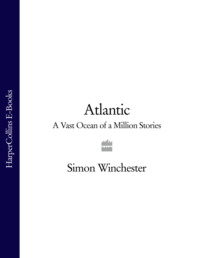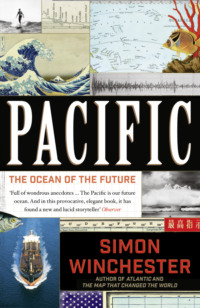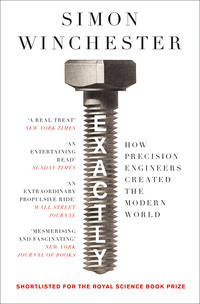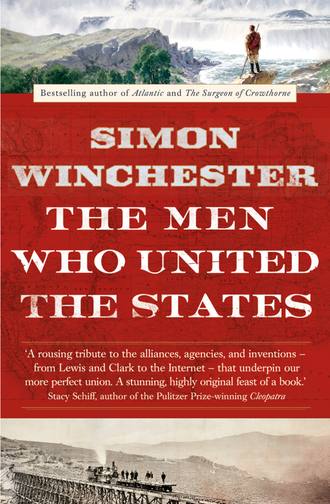
Полная версия
The Men Who United the States: The Amazing Stories of the Explorers, Inventors and Mavericks Who Made America
One could imagine that Clark would have rather liked to stay, but just after lunch the next afternoon, they set off—“under three Cheers,” wrote Clark, “from the gentlemen on the bank.”
They headed first directly toward the west, toiling against a slow river current and the whirling of the deadly water-boils they would endure for the next fifteen months, and until they eventually crossed the unknown, unimagined wilderness of the Continental Divide after more than three thousand miles of travel.

They spent the first six weeks journeying easily enough through what is now the state of Missouri. During the early miles, a number of limestone cliffs and sandstone bluffs rise up beside the stream—indeed, Clark fell from one three-hundred-foot pinnacle early in the trip, saving himself only by digging his knife into a crevice and dangling there until he felt brave enough to clamber back up. But generally the countryside here is more floodplain than valley, more prairie than canyon, and the river winds and wanders irrationally, all over the place.
The party found they were making only minimal forward progress, even though their daily distances turned out to be wearyingly long. Today the highways and the Union Pacific rail lines follow much the same exhausting path along the riverbank. They do so not because contour lines compel them to, but because if they tried to go straight where the river winds—with every single bend given a name, Bushwhacker Bend, Bootlegger Bend, Cranberry Bend—far too many costly bridges would be required. It is more prudent and economical to follow the stream than to fight it, today just as it was back in the expedition’s time.
THE FRONTIER AND THE THESIS
After some weeks of sailing and rowing and poling along a willow-banked river, the party reached a junction, with a river they called the Kaw, today the Kansas River. The leaders were at last quite impressed with the landscape—“the countrey about the mouth of this river is verry fine,” wrote Clark, and said it would be a good site for a future army fort.
The army must not have agreed, but civilian settlers eventually did, in their thousands, for they later turned the spit of land between the two streams into an enormous campsite, a base for the long and heroic westward treks along the Oregon Trail, the Santa Fe Trail, and the California Trail. And the metropolis that some of their number then stayed behind to build, Kansas City, has become a classic of frontier America.
I had been here before, some thirty years earlier. It was shortly before the bicentennial celebration of 1976, when I spent six months traveling through the Midwest, trying to understand the importance of that uniquely American phenomenon, the frontier. Along the way I had met many people and had seen many things: two of the more memorable happened to be right here, where Lewis and Clark were pressing westward through the very frontier I was studying.
The first encounter was of rather lesser importance, though it still had some poignancy. I had been invited to visit a marble memorial to an enormous white Charolais bull. He was named Sam 951, and until 1972 he had lived on a ranch in the town of Chillicothe and had been famous for miles around as an example of bovine excellence. Sam’s frozen semen, once produced in exuberant gallons by what all agreed was an excessively jolly creature, was worth millions, and was packaged in nitrogen-cooled vials to be sent off from Chillicothe to eager customers all over the world.
The Litton Charolais Ranch was in consequence once perhaps the most profitable cattle-breeding outfit in America. Sam 951 was primus inter pares of the large and carefully managed herd. Each bull—the best of them lived in air-conditioned barns kitted out with red carpets—weighed a ton or more, had ears the size of dinner plates, had a vast muscular body joined necklessly to an appropriately immense head, and sported dewlaps that would take two strong hands to move.
Cattle like Sam had made a great fortune for the ranch owner, Jerry Litton, and had now brought him within a hair’s breadth of true fame. I spent two happy summer days with him—a handsome and engaging man who had married a former Miss Chillicothe (and a runner-up in the Miss Missouri pageant) and who for the previous four years had been a member of the US Congress, a Democrat. His home at the time I stayed was abuzz with political excitement: in two weeks voters were due to decide whether or not to elect him a US senator. Many, indeed, thought he would and should run for national office—President Jimmy Carter was a supporter—and in early 1976 he was sufficiently intrigued to announce that he would indeed take this obvious next step along the political glide path.
When I turned up, his work was nearly all wrapped up. He was in the closing stages of what all agreed had been an impeccably nuanced and well-funded campaign for the primary election. And two weeks after I left, he did indeed triumph, leading a stunning upset in a twelve-man primary race. Jerry Litton was on the verge, I have long since believed, of well-deserved political greatness.
On the night of his victory, he was to be flown back to Kansas City for a celebration. But then came calamity. The crankshaft in one of the engines sheared in half; the little plane lost power and crashed on takeoff; and Litton, his wife and children, his Beech Baron’s pilot, and the pilot’s son were all killed. Jerry Litton had been born in a house without electric power, in 1937, when this part of Missouri still had the feel of the frontier about it. He would have brought something of this spirit to Washington had fate permitted it. He was a figure of whom it can rightly be said, He could have been a contender. But fate saw to it that he never got the chance.
My second excursion of that 1976 adventure concerned the polar opposite of a cattle farm. I spent time touring a sprawling Minuteman nuclear missile site, centered at the Whiteman US Air Force Base, an immense complex of men and their flying machines set close by a village just south of the river with the engaging name of Knob Noster. Back in the 1970s, it was quite possible to visit the immense missiles and to descend deep into the bunkers where clean-cut young officers—curiously decked out in uniforms that included starched white ascot collars—sat beside their pairs of launch switches, enduring a bleak shift of existence in air-conditioned subterranean silence, waiting to execute a world-destroying command that, mercifully, never came.
The Cold War is now over, but America still has deployed around the country three wings of Minuteman missiles, all nuclear tipped and more powerful than ever, as ready to go as ever they were before. They are, however, no longer deployed in Missouri but in more distant and protected wilderness bases in North Dakota, Wyoming, and Montana. One can still try walking across lonely Montana meadows up to the edge of the wire-protected silo where a missile lurks beneath its concrete blast doors, to test how long it takes before a security jeep or a helicopter, with flashing blue lights and a crew of soldiers with full authority to maim, comes to find out what you are up to. Back in Missouri in the 1970s, I was invited to try and found it took no more than a couple of minutes for my breach of security to be discovered and repulsed. But it is no longer possible to play such a game at the Whiteman Base there since the men have all been stood down and their missiles dismantled and destroyed under the terms of the various treaties signed with a Russia that is no longer the Soviet Union, no longer seen as quite the threat it once was.
Yet Whiteman Air Force Base itself still exists, and if not armed with missiles today, it still sports a title and wields an ability that sends chills down spines. It is part of a terrifying arsenal of weaponry that is now called—after numerous organizational changes and semantic alterations of title—the United States Air Force Global Strike Command.
The command has its headquarters in Louisiana, from where it controls all of America’s air-launched atomic weapons—the three Minuteman missile wings in the northwest and a large number of B-2 stealth bombers, all of them designed to drop thermonuclear bombs. The bulk of these bombers happen to be based at Whiteman—at a site a short way from that point on the river where, in 1804, William Clark recorded hearing an “emence snake” that inhabits a small lake nearby “and which gobbles like a Turkey & may be herd several miles.”
The planes belong to a US Air Force wing, the 509th, that proudly reminds visitors that it is the direct descendant of the only unit in history that has ever dropped live atomic bombs in wartime, on Hiroshima and Nagasaki in 1945. Today it is a battle-proven assemblage of aircraft and crew that, its commander says, can now bring massive firepower to bear, in a short time, anywhere on the globe.
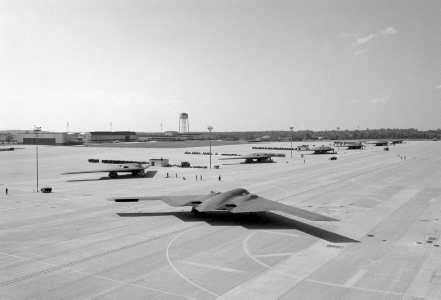
B-2 stealth aircraft of the 509th Bomb Wing, a twenty-strong nuclear-armed operational component of Global Strike Command, at Whiteman Air Force Base, Missouri. The wing is a direct descendant of the group that dropped atom bombs on Hiroshima and Nagasaki.
There seems a certain irony in this nuclear firebase being located so very close to the Lewis and Clark expedition route, not least because what Jefferson’s explorers were seeking to do, even if unknowingly at the time, was tied to the unique American concept of the frontier and to the development of what to this day is known—and argued over—as the frontier thesis. The irony stems from the argument that the frontier mentality, if such a thing truly exists, still plays a nourishing—and controversial—role at the intellectual roots of much of today’s American foreign policy.
The famous argument, put forward in an 1895 paper by a University of Wisconsin history professor, Frederick Jackson Turner, held that there was an immense social significance in the simple existence of the frontier—that ever-westward-shifting margin between civilized society in the East and the untamed savagery and wilderness to the West. Kansas City, the city that rose from one of the campsites of the Lewis and Clark Expedition, became a classic, if momentary, point of frontier contact: on its eastern side were traders, trappers, farmers, settlers, surveyors, villages, and towns; on its western side were empty prairies, nomads, lawlessness, and an unprotected and shelterless void of stony plains, tornadoes, and starvation. Between them lay the line of contact, division, and separation: the frontier.
The rolling clash between these two extremes gave rise, Turner argued, to a peculiarly American set of character traits. The experiences suffered or enjoyed on the frontier left Americans inherently different from what they and their antecedents had been in their homelands. Those tested in the borderlands were by comparison more violent, more informal, more democratic, more imbued with personal initiative, and less hamstrung by tradition, class, and elegance. More American, Turner suggested. Strength, power, might—the ability to tame rather than to persuade, the tendency to demand rather than request, the tendency to shoot rather than to talk—these were all tendencies compounded by the frontier experience, uniquely different building blocks employed in the making of the modern American. The Western myth, the legends of the cowboy, the cinematic and entertainment-park allure of concepts like Frontierland—all of these were born from this single simple (some would say simplistic) thesis offered by Frederick Jackson Turner.
In the century since the publication and promulgation of his views, Turner has been attacked roundly and mercilessly for ignoring such matters as race, gender, and regionalism. Yet what has gone essentially unanswered still remains: just why do Americans believe they are so different, so exceptional? Why the persistent belief in the idea of America as the “shining city on a hill”? Why the notion of Manifest Destiny?
And why, indeed, did Thomas Jefferson believe so keenly in the idea that America should and could and in time would extend herself from sea to shining sea, and accordingly dispatch Lewis and Clark to see if and how this could be achieved? Was all of this, as Frederick Jackson Turner would later argue, rooted in that same peculiar experience, shared by all, born in the process of the steady closing of the frontier?
Some may consider it injudicious to conflate, on the one hand, John Winthrop’s inspirational city-on-a-hill sermon of 1630 and the tenets of the frontier thesis with, on the other, the notion of conducting Manifest Destiny at home and so many interfering adventures abroad. And yet viewed from some perspectives it does seem right and proper to ask, particularly here in Missouri: why does America still believe, as the slogan of Whiteman Air Force Base has it—why did it ever believe, in fact—that it has a right and a duty to be able to deliver “massive firepower, in a short time, anywhere on the globe”? Why America? And if such a belief is somehow rooted in a deep-seated conviction that it should, that it needs to, and if called upon, that it must—then was not this all born, as Frederick Jackson Turner and his supporters would also argue, from the experiences gained by early Americans in their closing of the frontier? Isn’t this determination to extend itself across the planet simply a reflection of the strength and crudity and informal decisiveness of the pioneer Americans, brought up to date, made global, and now writ large for all the world to see?
Does the mission of the huge atomic firebase, sited so close to where William Clark first heard of the snake that gobbles like a turkey, have its intellectual origins in this very same tiny, brave expedition that first crossed the frontier and in the consequent development of the huge city now lying just a short drive away to the east, which once so vividly encapsulated the notion of the frontier, two centuries before?
These days it is by no means easy to see the inner workings of Whiteman. In the 1970s it was simplicity itself to win an invitation for a tour. The air force was only too proud then to show off its wares and its weaponry, reasoning that doing so helped display to the Soviets its perpetual readiness to strike. Today, terrorism has introduced a new reality: long scimitar glints of razor wire, battalions of ever-scanning cameras, and heavily armed sentries at the entrance gates all stand guard to protect the planes and their weapons from the innocently curious and the ill intentioned alike. Tours still happen, but application lines are long, details demanded weeks in advance, cameras forbidden.
Once in a while, though, along this steady reach of the wide Missouri, there will come a distinctively huge and quite unexpected rumbling sound, a thunder of jet engines that shakes the willows and the stillness of the stream. Then from its lair behind the wire, rising from an invisible runway folded among the cornfields, a great gray bomber will slowly lumber upward and hoist itself into the skies.
It is always an awesome sight—all the more so if other planes follow and the singleton becomes part of an airborne armada, a squadron of unimaginable power bound on an unannounced mission to a place no one will ever disclose for a purpose never to be known.4 As the craft vanish into the clouds and the thunder ebbs away over the woods, it is tempting to wonder just what corner of the planet might soon be basking under the unasked-for invigilation of these nuclear-tipped watchers from the skies.
It is at moments like this the irony of history presents itself. For it seems not too much of a stretch to suppose that America’s present-day global reach, insisted upon as a right and represented by weapons like this, is a concept that actually enjoyed its infancy here, more than two centuries ago. This was when two young soldiers, on orders from their president, were engaged on a mission to extend the reach of their young country, not then clear across the world, but from just one gray ocean clear across to another. The world would come later, when canoes became bombers and wooden paddles jet engines.
THE WOOD WAS BECOME GRASS
Beyond Kansas City the river turns northward, and William Clark offered his views about the kind of terrain that he believed now lay on its western bank. His spelling and grammar were never exemplary: on the evening of June 21, 1804, when he wrote this simple observation, he was probably quite weary:
Supplied with water the Small runs of (which losees themselves in the bottom land) and are covered with a variety of timber such as Oake of different Kinds Blue ash, walnut &c. &c. as far as the Praries, which I am informed lie back from the river at some places near & others a great distance.
The Praries, as he had it, were indeed nearby, and they were of a landscape very different from what had gone before.
Until this point in the journey, the expedition had been quite overwhelmed by trees, by forests, by glades, by copses—by wood. The valleys through which the men traveled and the hills they saw from the water were usually thick with trees. They were burned in some places by Indians, who needed places to conduct their agriculture, but otherwise they seemed totally to carpet the land. Red and white pine forests; oak and chestnut forests, copses of hickory and cottonwood; groves of aspen, birch, maple, and cedar; stands of balsam fir, oak, ash, and walnut—all these and more make their way into the journals of Lewis and Clark, for whom scarcely a day went by without some mention of a tree or a wood or the worrisome absence of woodland where the explorers had believed it should be.
Though Lewis had some scant botanical training, the two were focused primarily on the commercial possibilities of timbering, not forest science per se. Early America ran on wood. People had an urgent need of it for every aspect of life, from fuel to housing, from boatbuilding to the making of crude paper and the construction of that most esteemed emblem of pioneer life, the log cabin. And in those settled parts of the country, wood was abundant. From the white pine forests of Maine to the magnolias of South Carolina and the elms and chestnuts, the cottonwoods and willows of Missouri Territory, the stripling America was bristling with trees.
Except, as William Clark was aware, this suddenly was not so anymore, on the west bank of the upper reaches of the Missouri River. Up on these riverbanks, sometimes close to the river, on other occasions some great distance away, and first seen in the long reaches upstream from where the river makes its directional shift from the west to the north, there appeared glimpses of a landscape now in a state of arboreal undress, much changed from what had gone before.
What Clark glimpsed was a relatively treeless brown-green country, stretching away into a violet horizon that was longer and flatter than any that these hill-born Easterners had ever witnessed or imagined before. It was landscape laid out, flatly undulating, beneath a sky so big it was overwhelming. It was a new kind of prairie, a limitless tableland of grass, a huge grazing-plain, with a wind that soughed near-constantly above the vegetation, the temperature of the drifting air the only clue to the season. Its sky was flecked with mare’s tails of clouds, where lightning could be seen a hundred miles distant and you could watch the black storms chewing their way toward you, the sky suddenly darkening overhead as the squalls arrived and smashed down wafting curtains of hail until the earth was quite white and crunched underfoot, though within moments the reappearing sun then melted it away, steam suddenly began to rise from the grass, and you could almost hear the plants bursting upward in the newly made and richly damp sauna of heat. America was someday to be a united nation, for sure, but in places its newly seen landscape evidently comprised the greatest imaginable differences.
The explorers had reached the eastern edge of that immense, hitherto mostly unseen and uniquely American geographical phenomenon: the Great Plains. Uniquely American, but not unique: there is no shortage of vast midcontinental expanses elsewhere—the Russian steppes, the African veldt, the Argentine pampas, and even some African savannas all offer much the same confluence of flattened topography, pitiless windblown climate, and endlessly unvarying botanical covering. But in America, the Great Plains have been sintered into what is now a cultural, as well as a geographic, entity—a tract of thinly settled grassland of between half a million and a million and a half square miles, depending on the chosen boundaries, a place and an entity that is now an essential component of what America has made of herself, part of the country’s shared triumph and, for many years, part of the narrative of her shared national tragedy, too.
The Great Plains boundaries are fugitive, vague lines that shift from year to year, drift from climate to climate, or wander and wobble like the polar axis. The sudden upsurge of the Rocky Mountains more or less marks their western limit. In the east, where Lewis and Clark became the first confirmed American explorers to encounter them,5 their boundary is ill defined at best. Some like to suggest that the Missouri itself provides the line. The land on the river’s eastern side is thick with lush vegetation, the soil so Russian black and damp and rich that some have remarked that it might as well be eaten without any need to pass vegetables through it. The lands on the far side, by contrast, are said to be parched and dusty, their grasses scrawny and patchy, and such meadows as exist having a persistent brown and sun-scorched look about them. But this is all a fancy; scarcely anywhere along the river is the division ever so neat and clear-cut. In fact, seldom can a traveler from the east be entirely sure he has truly entered the plains proper until their presence, after miles of slow and subtle alterations, becomes fully—and to some stunningly, even alarmingly—obvious. And that has little to do with the changing nature of soils or vegetation: it is generally when all the visible world around seems sky and endless curved horizons, where nothing else seems to exist before or behind or on either side but an apparently limitless, wind-hissing emptiness.
Though geology and glacial history have determined the extent and topography of the plains, it is quite simply rainfall—or rather, its lack—that is the real key to their existence. The climate patterns here are so classic that they might be lifted from a textbook. The huge, moisture-laden weather systems that trundle relentlessly eastward across the continent from the Pacific Ocean are forced upward as they pass over the Sierra Nevada and the Rockies; this ascent cools the air, reducing its capacity to hold water. Gravity then insists it fall as rain or snow on the crags below.
What happens next determines the fate of the plains; by the time the weather systems are done with the mountains and swish downward from the heights on their eastward drift, they are exhausted, wrung out, and bone-dry. They roll on for hundreds of airborne miles without immediate purpose, without maturing clouds, and without the will or ability to deposit any further moisture on the grounds below.
The flatlands beyond the Rockies thus lie in a rain shadow, and the vegetation that grows or clings to life within it is peculiar and appropriate to the waterlessness it imposes. And since the vegetation is almost always the key to both animal and human settlement, the role of these flatlands in at least the beginnings of the American story was as fully determined by it as in any other settled corner of the planet. Just as the Inuit and the polar bear inhabit the northern snow country, just as the Tuareg and the camel make their own very different kind of living in the hot African deserts, and just as the San and the Yamana and the Ainu and the Kazakh all adapt to their own unique habitats according to climate, topography, and the local flora and fauna, so too in these prairie parts one finds people and creatures uniquely suited to the conditions: the Comanche and the prairie dog, the Sioux and the rattlesnake, and all of the other Plains Indians—the Blackfoot, the Cheyenne, the Arapaho, and the Crow—together with uncountable millions of the single species of animal that once so dominated and symbolized the grass-covered landscapes here, the American bison.





